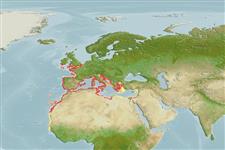>
Blenniiformes (Blennies) >
Tripterygiidae (Triplefin blennies) > Tripterygiinae
Etymology: Tripterygion: Greek, tres tria = three + Greek, pteron = wing, fin; diminutive (Ref. 45335).
Issue
Tripterygion xanthosoma is considered valid in Patzner et al. 2009:449 (Ref. 93609).
Environment: milieu / climate zone / depth range / distribution range
Écologie
marin démersal; profondeur 0 - 40 m (Ref. 4785), usually 6 - 12 m (Ref. 4785). Subtropical; 52°N - 12°N, 19°W - 36°E
Eastern Atlantic and Mediterranean Sea: English Channel southwards and along the coast of west Africa, including Madeira and the Canary Islands (Ref. 4785), south to Senegal.
Taille / Poids / Âge
Maturity: Lm ? range ? - ? cm
Max length : 8.9 cm TL mâle / non sexé; (Ref. 5294); common length : 6.0 cm TL mâle / non sexé; (Ref. 5294)
Adults inhabit shallow coastal waters with rocky substrate. They are found under overhanging rocks, entrances of caves and other biotopes with reduced light. In the Atlantic, they occur in shallow, light-exposed biotopes. They feed on benthic invertebrates, also on harpacticoids (Ref. 4785), amphipods and other copepods (Ref. 94105). Males court by figure-8-swimming (Ref. 4785). Eggs are hemispherical and covered with numerous sticky threads that anchor them in the algae on the nesting sites (Ref. 240). Larvae are planktonic which occur primarily in shallow, nearshore waters (Ref. 94114).
Life cycle and mating behavior
Maturities | Reproduction | Spawnings | Egg(s) | Fecundities | Larves
Wirtz, P., 1990. Tripterygiidae. p. 916-917. In J.C. Quero, J.C. Hureau, C. Karrer, A. Post and L. Saldanha (eds.) Check-list of the fishes of the eastern tropical Atlantic (CLOFETA). JNICT, Lisbon; SEI, Paris; and UNESCO, Paris. Vol. 2. (Ref. 5294)
Statut dans la liste rouge de l'IUCN (Ref. 130435)
Menace pour l'homme
Harmless
Utilisations par l'homme
Pêcheries: d'intérêt potentiel; Aquarium: potentiel
Outils
Articles particuliers
Télécharger en XML
Sources Internet
Estimates based on models
Preferred temperature (Ref.
123201): 12.5 - 21, mean 18.7 °C (based on 609 cells).
Phylogenetic diversity index (Ref.
82804): PD
50 = 0.5625 [Uniqueness, from 0.5 = low to 2.0 = high].
Bayesian length-weight: a=0.00562 (0.00258 - 0.01228), b=3.08 (2.89 - 3.27), in cm total length, based on LWR estimates for this (Sub)family-body shape (Ref.
93245).
Niveau trophique (Ref.
69278): 3.4 ±0.44 se; based on food items.
Résilience (Ref.
120179): Haut, temps minimum de doublement de population inférieur à 15 mois (Preliminary K or Fecundity.).
Fishing Vulnerability (Ref.
59153): Low vulnerability (10 of 100).
Nutrients (Ref.
124155): Calcium = 360 [191, 886] mg/100g; Iron = 2.16 [1.12, 4.22] mg/100g; Protein = 18.4 [17.3, 19.5] %; Omega3 = 0.264 [0.123, 0.562] g/100g; Selenium = 30.7 [11.3, 72.4] μg/100g; VitaminA = 11.1 [2.9, 41.2] μg/100g; Zinc = 1.65 [1.01, 2.57] mg/100g (wet weight);
